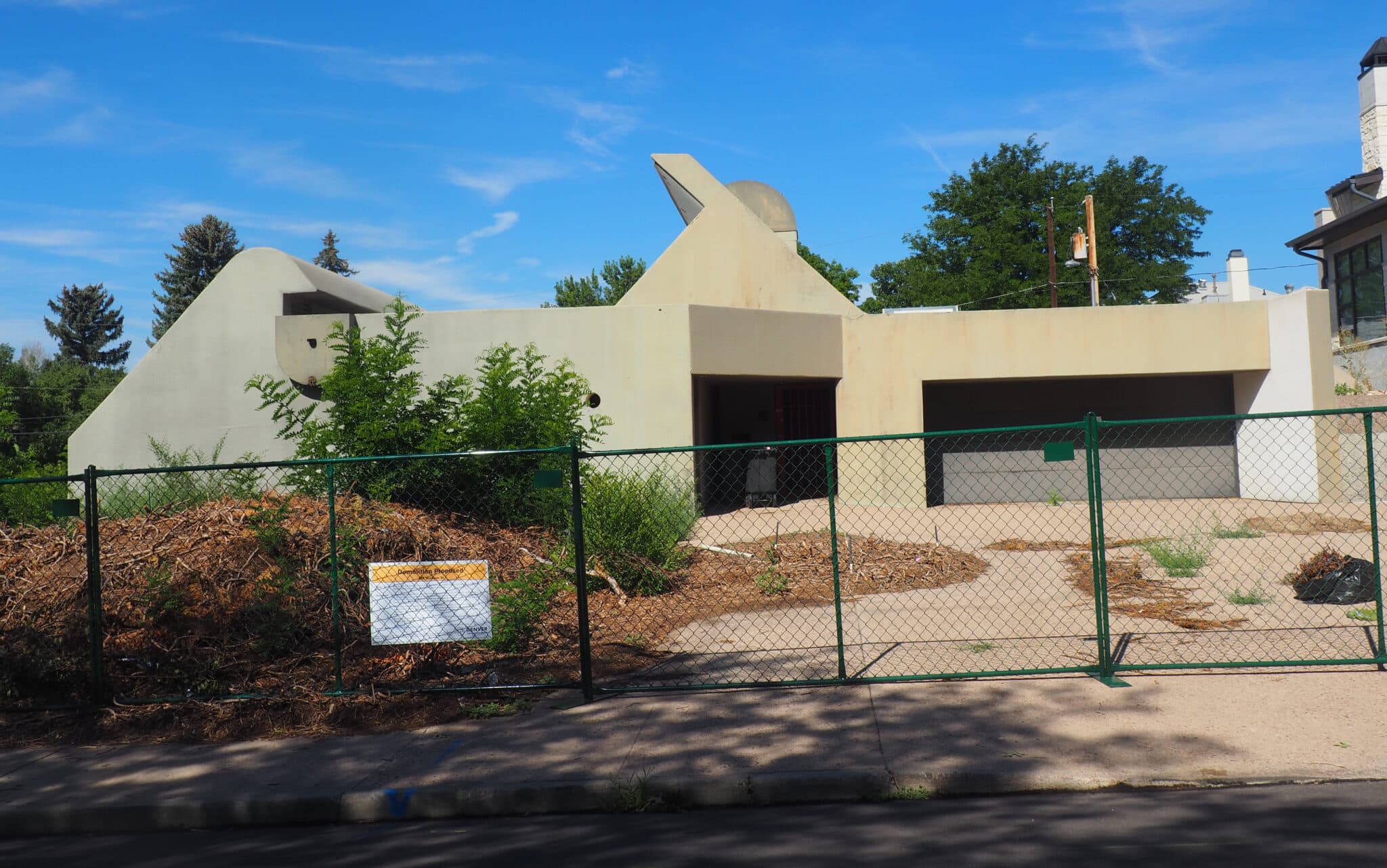
The new owner of the home at 401 N. Madison St. in Cherry Creek is a homebuilder that plans to demolish the home and construct two duplexes on the lot. (BusinessDen file photo)
Three Denver residents are spearheading a push to save a late architect’s Cherry Creek home from the wrecking ball.
A landmark designation application was filed in recent days for the home at 401 N. Madison St., which was designed and built in 1979 by and for Richard Crowther, who was known for his energy-conserving architecture. He died in 2006 at age 96.

Richard Crowther was known for his energy-conserving architecture. (Photo courtesy of Denver Public Library/Rocky Mountain News)
Landmark designation effectively prevents demolition of a structure. The designation is opposed by the current owner of the 401 N. Madison property, Denver-based Mag Builders.
BusinessDen reported in August that Mag had applied to demolish the structure. Mag Chief Financial Officer Michael Moylen said at the time that the firm, which paid $4 million for the 0.29-acre property in May, wanted to build a pair of duplexes in the high-priced neighborhood. The city posted notice of the demolition application publicly.
The new landmark application was submitted by Tom Hart, Alan Gass and Michael Hughes. Hart and Gass are architects, and Hart is on the board of trustees of nonprofit Historic Denver. Hughes owns a home in the Hilltop neighborhood designed by Crowther, according to design magazine Modern in Denver.
“It’s a stunning early example of sustainable design, way ahead of its time,” Hall said in a Tuesday email.
The home embodies the Late Modern architectural style, the men wrote in the application. The structure is made of concrete, and horizontally oriented, except for large, angled windows that capture the sun’s radiation.
The home was a “research residence” for Crowther, who moved to Denver in 1948.
“Although not his first passive solar design, it was completed at the height of his architectural career and served as his home and laboratory for many years,” the application states. “Crowther’s dedication to sustainability in architecture and green design was well-known.”
Crowther designed Cooper Cinerama movie theaters, both in Denver and elsewhere, as well as buildings for King Soopers and the Joslins department store chain, according to a report written by city staff. He also designed the ride entrances and ticket booths for Lakeside Amusement Park.
Crowther also designed so many homes near Denver Country Club that he wryly told the paper in 2003, “I started Cherry Creek North without knowing it.”
Moylen, of Mag Builders, didn’t respond to a request for comment on Tuesday. But the application notes that the three men, guided by a city-appointed mediator, spoke with the company prior to submitting the formal bid for preservation.
The application states that Mag said it wasn’t interested in preserving the structure, but that the company might be willing to sell it to someone who would. As of the end of September, however, the applicants hadn’t been able to find a possible buyer.
Assuming an alternate resolution is not found, the application will on Nov. 1 go before Denver’s Landmark Preservation Commission, which will decide whether to forward it to the City Council for a vote.
In the past, council members have been reluctant to support owner-opposed landmark applications. In 2021, the council unanimously rejected one for television station Denver7’s building at 123 Speer Blvd. In 2020, those seeking to preserve the Carmen Court condo complex at 900 E. 1st Ave. withdrew their application because they determined they likely didn’t have the necessary council support.
Other landmark fights — over the Tom’s Diner building at 601 E. Colfax Ave. and a shuttered funeral home in the Berkeley neighborhood — ended before a council vote when a preservation-minded buyer was found.
Richard Crowther and his wife Pearl owned the 401 N. Madison home until their deaths in 2006 and 2007, respectively, records show. The home sold three times before Mag purchased it this past May.
One potential complicating factor for preservation is the home’s condition. Moylen said in August that it had been vacant for five years.
“It’s a mess inside,” Moylen said at the time. “The house is in shambles. There’s orange countertops, like the ‘Brady Bunch,’ a pool in the basement, and a hole in the roof and birds inside.”
In their landmark application, however, Hart, Gass and Hughes basically argued that the structure still has good bones.
“The exterior of the house retains a remarkably high degree of integrity because of its substantial basic structure of reinforced concrete exterior walls and interior floor, notwithstanding recent cosmetic vandalism,” they wrote.

The new owner of the home at 401 N. Madison St. in Cherry Creek is a homebuilder that plans to demolish the home and construct two duplexes on the lot. (BusinessDen file photo)
Three Denver residents are spearheading a push to save a late architect’s Cherry Creek home from the wrecking ball.
A landmark designation application was filed in recent days for the home at 401 N. Madison St., which was designed and built in 1979 by and for Richard Crowther, who was known for his energy-conserving architecture. He died in 2006 at age 96.

Richard Crowther was known for his energy-conserving architecture. (Photo courtesy of Denver Public Library/Rocky Mountain News)
Landmark designation effectively prevents demolition of a structure. The designation is opposed by the current owner of the 401 N. Madison property, Denver-based Mag Builders.
BusinessDen reported in August that Mag had applied to demolish the structure. Mag Chief Financial Officer Michael Moylen said at the time that the firm, which paid $4 million for the 0.29-acre property in May, wanted to build a pair of duplexes in the high-priced neighborhood. The city posted notice of the demolition application publicly.
The new landmark application was submitted by Tom Hart, Alan Gass and Michael Hughes. Hart and Gass are architects, and Hart is on the board of trustees of nonprofit Historic Denver. Hughes owns a home in the Hilltop neighborhood designed by Crowther, according to design magazine Modern in Denver.
“It’s a stunning early example of sustainable design, way ahead of its time,” Hall said in a Tuesday email.
The home embodies the Late Modern architectural style, the men wrote in the application. The structure is made of concrete, and horizontally oriented, except for large, angled windows that capture the sun’s radiation.
The home was a “research residence” for Crowther, who moved to Denver in 1948.
“Although not his first passive solar design, it was completed at the height of his architectural career and served as his home and laboratory for many years,” the application states. “Crowther’s dedication to sustainability in architecture and green design was well-known.”
Crowther designed Cooper Cinerama movie theaters, both in Denver and elsewhere, as well as buildings for King Soopers and the Joslins department store chain, according to a report written by city staff. He also designed the ride entrances and ticket booths for Lakeside Amusement Park.
Crowther also designed so many homes near Denver Country Club that he wryly told the paper in 2003, “I started Cherry Creek North without knowing it.”
Moylen, of Mag Builders, didn’t respond to a request for comment on Tuesday. But the application notes that the three men, guided by a city-appointed mediator, spoke with the company prior to submitting the formal bid for preservation.
The application states that Mag said it wasn’t interested in preserving the structure, but that the company might be willing to sell it to someone who would. As of the end of September, however, the applicants hadn’t been able to find a possible buyer.
Assuming an alternate resolution is not found, the application will on Nov. 1 go before Denver’s Landmark Preservation Commission, which will decide whether to forward it to the City Council for a vote.
In the past, council members have been reluctant to support owner-opposed landmark applications. In 2021, the council unanimously rejected one for television station Denver7’s building at 123 Speer Blvd. In 2020, those seeking to preserve the Carmen Court condo complex at 900 E. 1st Ave. withdrew their application because they determined they likely didn’t have the necessary council support.
Other landmark fights — over the Tom’s Diner building at 601 E. Colfax Ave. and a shuttered funeral home in the Berkeley neighborhood — ended before a council vote when a preservation-minded buyer was found.
Richard Crowther and his wife Pearl owned the 401 N. Madison home until their deaths in 2006 and 2007, respectively, records show. The home sold three times before Mag purchased it this past May.
One potential complicating factor for preservation is the home’s condition. Moylen said in August that it had been vacant for five years.
“It’s a mess inside,” Moylen said at the time. “The house is in shambles. There’s orange countertops, like the ‘Brady Bunch,’ a pool in the basement, and a hole in the roof and birds inside.”
In their landmark application, however, Hart, Gass and Hughes basically argued that the structure still has good bones.
“The exterior of the house retains a remarkably high degree of integrity because of its substantial basic structure of reinforced concrete exterior walls and interior floor, notwithstanding recent cosmetic vandalism,” they wrote.
